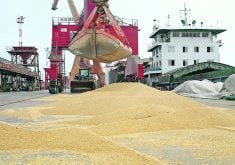World feed grain demand is not good early in the 2022-23 crop marketing year, says an analyst.
“There is a trend developing that China will take a lesser amount of feed grains this crop year than prior years,” said Dan Basse, president of AgResource Company.
China imported 550,000 tonnes of corn in October, 58 percent below year-ago levels. Barley imports fell 74 percent and sorghum was down 34 percent to 610,000 tonnes.
Read Also

Agritechnica Day 3: Hybrid drive for a combine, data standards keep up to tech change and tractors of the year
Agritechnica 2025 Day 3: Hybrid drive for a combine, data standards keep up to tech change and tractors of the year.
“The market has a much different tone. The last couple of years have been bullish from harvest all the way up until spring,” he said. “This year is not that kind of year. This year we’ll probably make our highs early.”
Basse said there are a few possible reasons why China’s feed grain purchases are lagging this year.
“We keep hearing talk that China is back allowing feed additives, the kind of things they used to feed before African swine fever,” he said.
That would include things like restaurant waste. At one time China was feeding 34 million tonnes per year of table scraps to its hogs, but it banned that practice when ASF crippled the industry.
“That produced the world corn buying binge the last couple of years, but now they seem to be backing away from (the ban),” said Basse, although he noted it is hard to verify any rumours coming out of China, especially in the COVID era.
Export numbers reveal that something has changed. China has only purchased three million tonnes of U.S. corn this year, 1.3 million tonnes of which has been shipped.
The U.S. Department of Agriculture is forecasting that China will import 18 million tonnes of corn this year, down from 21.9 million tonnes last year and 29.5 million tonnes the year before that.
Basse and others think it could be more like 15 or 16 million tonnes.
China recently sold 30 million tonnes of broken rice and some poor-quality wheat at government auctions.
“The stuff was going bad, and they needed to move it,” said Basse. “We think that hurt corn or feed grain demand.”
Another contributing factor is that China’s hog herd is shrinking despite handsome margins of up to US$90 per head.
“You would have thought they would be expanding their herds with that kind of margin, but I guess COVID is kind of keeping them from doing that.”
Chinese feed demand may materialize later, but Basse doesn’t think it will be filled by U.S. corn.
Brazil signed a phytosanitary agreement with China in May, paving the way for grain exports to the Asian giant. In November, news broke that China’s general customs administration approved 136 Brazilian facilities to export corn to China.
Reuters reports that grain exporter Anec is forecasting that China could buy five million tonnes of Brazilian corn in 2023.
Basse said corn from Ukraine and Brazil is much cheaper than U.S. corn, due in part to shipping problems on the Mississippi River. He shudders to think what will happen if there is a rail strike in the U.S.
If South America produces a good crop of corn in 2023, he can see a scenario where prices could fall for the next 18 months. That would not bode well for other grain prices because corn is the price leader.
Contact sean.pratt@producer.com
















